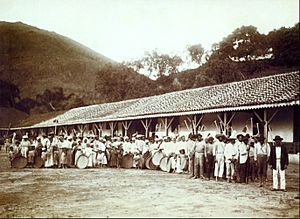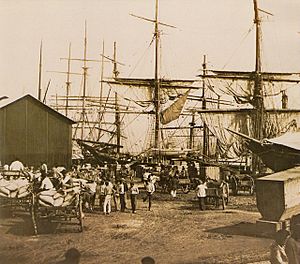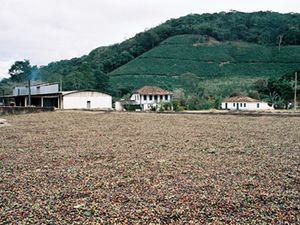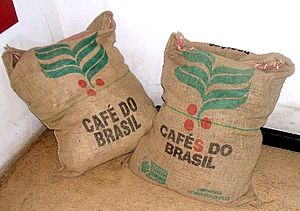Coffee production in Brazil facts for kids
Brazil grows about one-third of the world's coffee, making it the biggest producer by far! Huge coffee farms, covering an area of about 27,000 square kilometers (that's like 10,425 square miles!), are mostly found in the southeastern states of Minas Gerais, São Paulo, and Paraná. These places have the perfect weather and environment for coffee plants to grow well.
Coffee first arrived in Brazil in the 1700s. By the 1840s, Brazil was already the top coffee producer. Brazilian coffee really took off in the early 1800s when many immigrants came to work on the farms. Brazil produced the most coffee compared to the rest of the world in the 1920s. However, its share has gone down since the 1950s because other countries started growing more coffee too.
Contents
History of Brazilian Coffee
Coffee plants didn't originally grow in the Americas; they had to be brought here. The first coffee bush in Brazil was planted by Francisco de Melo Palheta in Pará in 1727. A popular story says that Portugal wanted to join the coffee market, but they couldn't get seeds from neighboring French Guiana. The governor there didn't want to share them. So, Palheta was sent on a special trip to solve a border problem. On his way back, the governor's wife, who liked Palheta, secretly gave him a bouquet of flowers with coffee seeds hidden inside! This is how he supposedly smuggled the seeds into Brazil.
Coffee growing spread from Pará and reached Rio de Janeiro by 1770. At first, it was only grown for people in Brazil to drink. But in the early 1800s, people in America and Europe wanted more coffee. This started the first "coffee boom." From the 1830s to the 1850s, coffee farms in Rio de Janeiro, São Paulo, and Minas Gerais grew very quickly. By the 1830s, coffee became Brazil's biggest export. By the 1840s, Brazil was producing 40% of the world's coffee, making it the largest producer.
In the early days, the coffee industry relied on slavery. In the first half of the 1800s, 1.5 million enslaved people were brought to Brazil to work on the farms. When the international slave trade was made illegal in 1850, farm owners started hiring more and more European immigrants. However, slavery within Brazil continued until it was finally ended in 1888.
The second big coffee boom happened from the 1880s to the 1930s. This time was known in Brazilian politics as café com leite (which means "coffee with milk"). This name came from the main products of the two biggest states: coffee from São Paulo and dairy (milk) from Minas Gerais. During this period, the Brazilian government also started a practice called "valorization." This was a way to keep coffee prices stable by buying extra coffee harvests and selling them later when prices were better.
The growing coffee industry brought millions of immigrants to Brazil. It also helped turn São Paulo from a small town into a huge industrial city. São Paulo's population grew from 30,000 in the 1850s to 1 million by the 1930s, making it Brazil's largest city and a very important center for industry.
By the early 1900s, coffee made up 16% of Brazil's total economy and three-quarters of its export money. The coffee growers and sellers had a lot of power in politics. For example, in 1906, the Taubaté Agreement showed how much influence São Paulo's coffee production had. When there was too much coffee, prices would drop. To protect the coffee industry, the government would buy the extra coffee. This plan helped keep prices up and encouraged more coffee growing. However, it also led to too much coffee worldwide, which made the problems worse during the Great Depression in the 1930s.
In the 1920s, Brazil was almost the only supplier of coffee to the world, providing 80% of it. But since the 1950s, Brazil's share of the market has slowly gone down as other countries started producing more. Even though its share dropped, coffee still made up 60% of Brazil's total exports as late as 1960.
Changes in the 1990s
Towards the end of the 1980s, people started wanting milder and better quality coffee. This caused disagreements about how much coffee each country could export under the International Coffee Agreement. Brazil didn't want to reduce its export limits, fearing it would lose its market share. Countries like the United States wanted higher quality coffee and didn't like that coffee was sold cheaper to countries not part of the agreement.
Because an agreement couldn't be reached, the International Coffee Agreement ended in 1989. As a result, the Brazilian Coffee Institute, which used to control how much coffee was grown and sold, was closed down. This was done to allow the market to control itself more freely. Before this, coffee companies didn't focus much on quality because government rules favored making large amounts of coffee. But after the changes, they started focusing on producing higher quality coffee.
Coffee Production in Brazil
Where Coffee is Grown
The six Brazilian states with the most land used for coffee are Minas Gerais (1.22 million hectares), Espírito Santo (433,000 hectares), São Paulo (216,000 hectares), Bahia (171,000 hectares), Rondônia (95,000 hectares), and Paraná (49,000 hectares).
Brazil has been the world's largest coffee producer for the past 150 years. Today, it produces about one-third of all coffee. In 2011, Brazil was the top producer of green coffee, arabica coffee, and instant coffee. That year, Brazil produced 2.7 million tons of coffee, which was more than double the amount of Vietnam, the second largest producer. About 3.5 million people work in the coffee industry, mostly in rural areas.
How Coffee is Grown and Processed
There are about 220,000 coffee farms in Brazil, covering about 27,000 square kilometers (10,425 square miles).
Most coffee farms are in the southeastern states of Minas Gerais, São Paulo, and Paraná, where the climate is perfect. Minas Gerais alone produces about half of Brazil's coffee. Most coffee is harvested during the dry season, from June to September. This is usually one big harvest each year when most of the coffee berries are ripe.
In many countries, arabica coffee beans are processed using a "wet process." But in Brazil, almost all coffee is processed using the "dry process" (also called "natural coffee"). In this method, the whole coffee berries are cleaned and then spread out in the sun to dry for 8 to 10 days. If the weather isn't good, it can take up to four weeks. After drying, the outer layer of the berry is removed in a hulling process. Then, the beans are sorted, graded, and packed into 60-kilogram bags.
Types of Coffee Plants
There are different types of coffee plants, but two main ones are grown for their beans: arabica and robusta. Arabica is the most common, making up about 70% of all coffee produced in Brazil and worldwide. Robusta makes up the other 30%. In Brazil, arabica coffee is grown mostly in states like Minas Gerais. Robusta is mainly grown in the smaller southeastern state of Espírito Santo, where about 80% of the coffee is robusta. Recently, the state of Rondônia in the northwest has also started growing a lot of robusta.
The Danger of Frost
Coffee plants can handle cool temperatures, but they can't survive frost. A mild frost, called a "white frost," kills the coffee flowers. But new flowers will grow back the next season, so it only affects the next year's harvest. However, a more serious frost, called a "black frost," kills the entire coffee tree. This has much longer-lasting effects because new plants have to be planted, and it takes 3 to 4 years for them to start producing coffee again.
Brazil is the only major coffee producer that is affected by frost. A harsh frost in Brazil can cause the world price of coffee to go up a lot because Brazil produces so much of it. These severe frosts happen about every five or six years, causing prices to change a lot in the market.
For example, a very damaging black frost happened on July 18, 1975, hitting Paraná, Minas Gerais, and São Paulo the hardest. The harvest right after, in 1975-76, wasn't too badly affected, but the 1976-77 harvest was hit hard, with 73.5% of the crops damaged. The price of coffee doubled in 1976-1977 and didn't go down until a good harvest in August 1977. The last severe frost was in 1994, when two harsh frosts hit in June and July. While not as bad as 1975, these frosts reduced the next year's harvest by 50-80% in some states and caused worldwide prices to rise.
Coffee Processing Industry
The coffee processing industry in Brazil is split into two main parts: ground/roasted coffee and instant coffee. The market for ground and roasted coffee has many companies competing, with over 1000 firms in 2001. However, the instant coffee market is controlled by just four big companies that make up 75% of it. Brazil is the world's largest exporter of instant coffee, with instant coffee making up 10-20% of all coffee exports. Both types of coffee are mainly sent to the United States, which is the world's biggest coffee consumer.
Coffee Exports
Coffee is still an important export for Brazil, but its importance has gone down in the last 50 years. From the 1850s to the 1960s, coffee exports made up over 50% of Brazil's total exports, reaching a high of 63.9% in 1950. This percentage started to drop in the 1960s as Brazil began exporting more of other products. By 1980, coffee exports were down to 12.3% of the total, and by 2006, they were only 2.5%.
Brazil itself is now the largest consumer of coffee, passing the United States in the mid-2010s. When looking at how much coffee each person drinks, Brazil is the 14th largest consumer. It is also one of the few coffee-producing countries, along with Ethiopia, that drinks a lot of its own coffee.
Taxes on Coffee
There are no taxes on coffee exports from Brazil. However, if you import green (unroasted) or roasted coffee into Brazil, there is a 10% tax. Instant coffee imported into Brazil has a 16% tax. Unprocessed coffee can be exported without taxes to the three biggest markets: the United States, the European Union, and Japan. But processed coffee, like roasted beans, instant coffee, and decaffeinated coffee, has a 7.5% tax when exported to the EU and a 10% tax to Japan. Exports to the United States are tax-free.







